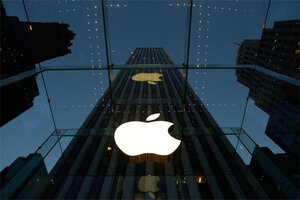Could Apple's rumored iWatch be as popular as the iPhone? One analyst says it might be.
A Morgan Stanley analyst predicts Apple will sell between 30 and 60 million units of the rumored iWatch during its first year, in large part due to brand loyalty.

In this Wednesday, Nov. 20, 2013, file photo, the Apple logo is illuminated in the entrance to the Fifth Avenue Apple store, in New York.
Mark Lennihan/File/AP
The rumored Apple iWatch could sell better than you think.
How much better? Well, according to a Morgan Stanley research report, between 30 million and 60 million units of the wearable device priced at $300 could be sold in the first year alone, "based on historical penetration of past iDevice[s]." The driving force behind those sales? Brand loyalty, the report notes.
The report from Morgan Stanley analyst Katy Huberty, which was obtained by Fortune, explains that Apple's brand loyalty for its iPhone has risen to 90 percent as of March 2014. That's up from 83 percent in December 2012 and 73 percent in December 2011, according to the report. The report further notes that smartphone brand loyalty for rival Samsung – which also makes the Gear line of smart watches – has increased at a more rapid rate in recent years, up to 77 percent in March 2014 from 63 percent in December 2012. Still, Samsung does not command the same kind of following in the smartphone market as Apple does.
It is this loyal following along with the so-called "halo effect," Ms. Huberty notes, that will spur customers to purchase the new iWatch, not current trends for existing similar devices. For example, just as it was inaccurate to initially compare the Apple iPhone's performance to the existing BlackBerry handset, it would be inaccurate to compare this new Apple smartwatch to, say, the performance of the Samsung Gear Live, notes the International Business Times.
In Huberty's best-case scenario, the iWatch will follow the same trajectory as the iPad upon its release, selling 60 million units, with Apple's stock rising to $132 per share. Her worst-case scenario has consumers showing little interest in wearable devices and Apple's stock falling to $74 per share, according to Fortune.
The rumor mill has been steadily cranking out new reports and analyses of a so-called iWatch in the past few months, as many expect Apple to release its entrant into the smart watch race as soon as this fall. Some reports have priced a potential iWatch at more than $1,000, a steep climb north of Huberty's estimate of $300 a pop. Other reports have described how Apple is working on powering a smart watch with a curved solar panel, possibly allowing the device to go for days without needing to be plugged into an electric power source.
Last month, at its annual Worldwide Developer's Conference, Apple unveiled HealthKit, an all-in-one workout and diet application for its new mobile operating system iOS 8. That app, which will let users aggregate existing fitness information from third-party apps such as those from Nike and Fitbit, was widely taken as Apple's teaser for a smart watch that would make its debut in the fall.
And yet, as respected Apple analyst Ming-Chi Kuo told AppleInsider last week, the iWatch "represents a new level of difficulty for Apple in regard to both hardware and software development." As such, Kuo said large-scale production on the device will be pushed to mid or late-November, instead of late September, as had been previously believed. By Kuo's estimate, Apple will sell about 3 million iWatches by the end of the year, according to AppleInsider, which also notes that the iWatch is "thought to sport a flexible AMOLED display complete with sapphire cover glass."
The prevalence of wearable devices is expected to grow in coming years. Wearables are expected to more than triple in number this year, reaching more than 19 million units in 2014, according to market research firm IDC. And by 2018, IDC estimates shipments for wearables will reach around 112 million.
Examples of other wearables currently on the market include Google Glass, the Samsung Galaxy Fit, the Pebble Smartwatch, and the LG G Watch.

